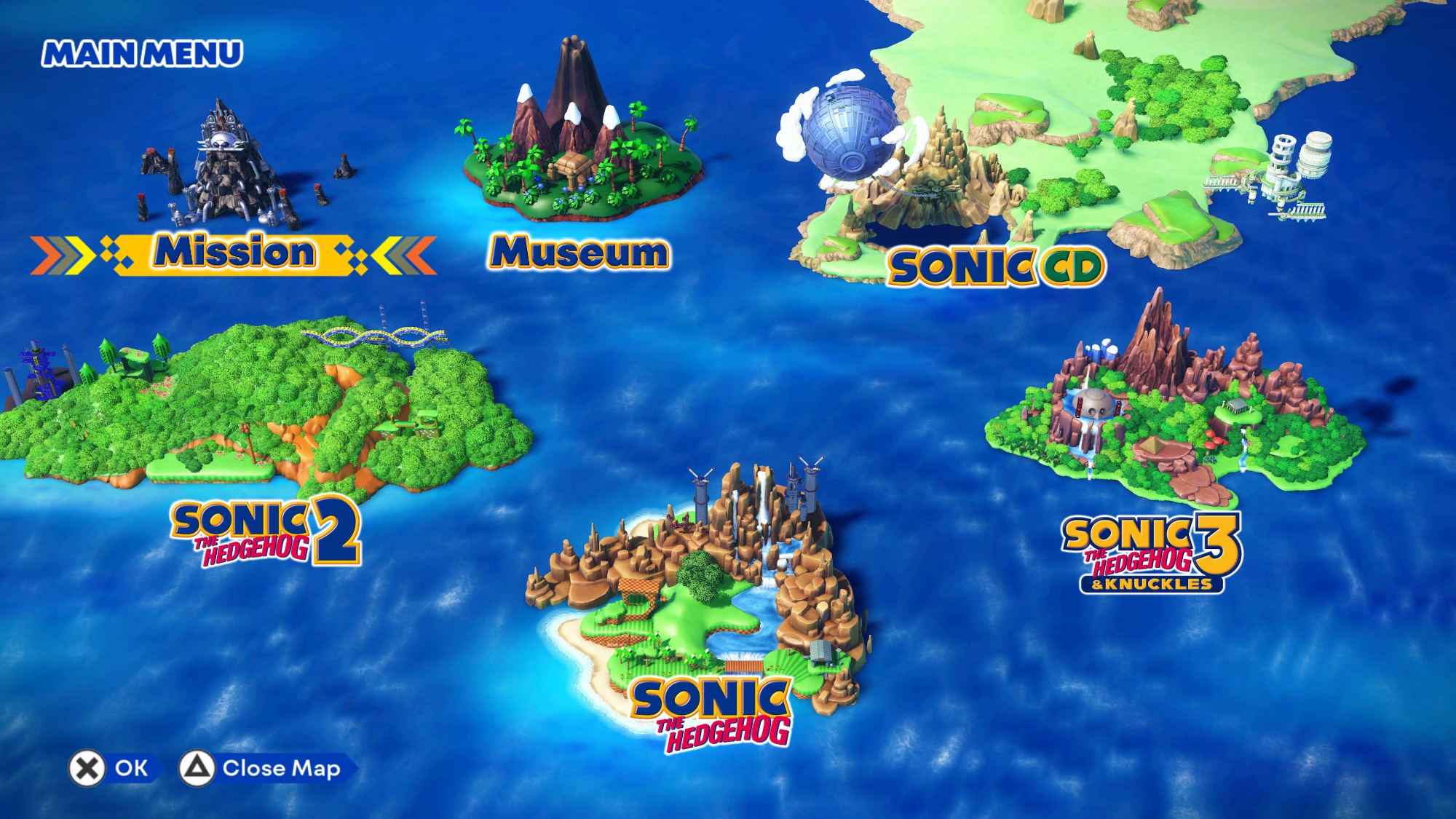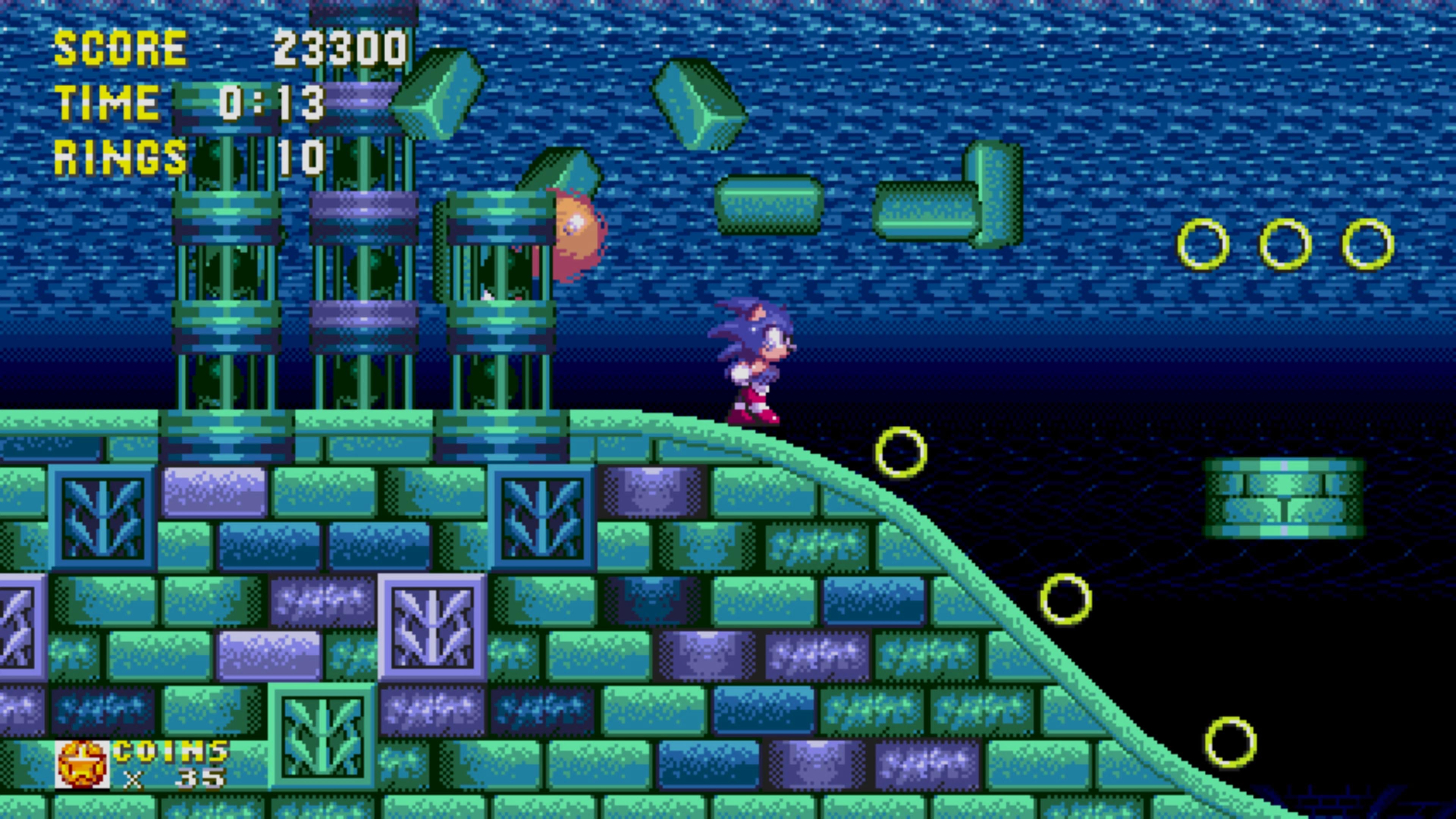Tom's Guide Verdict
Sonic Origins compiles the best 2D Sonic games of the 16-bit era. Although this collection is sound, it does have some issues that prevent it from being as good as it could be.
Pros
- +
Four great Sonic games in one package
- +
Updated graphics
- +
New animated cutscenes
- +
A slew of bonus content
Cons
- -
No CRT filters
- -
Altered Sonic 3 soundtrack
Why you can trust Tom's Guide
Platforms: PlayStation 4, PlayStation 5, Xbox One, Xbox Series X|S, Nintendo Switch, PC
Price: $40
Release Date: June 22, 2022
Genre: 2D platformer
Sonic Origins is the latest in a long line of Sonic the Hedgehog collections released over the past quarter-century. This compilation features Sonic the Hedgehog, Sonic 2, Sonic 3 & Knuckles and Sonic CD – and Sega has remastered all of them. Sonic Origins also has added features, all-new content and a couple of new modes.
So, what differentiates this collection from the others? Like Sonic Mania and the Sonic CD remaster, this compilation comes from programmer Christian Whitehead and developer Headcannon. Because of that, the games look fantastic on modern platforms, such as the PS5, Xbox Series X and PC. There are also a number of gameplay enhancements that make the titles easier for modern audiences. Newly created cutscenes for each game also help the collection stand out from previous iterations.
On its own, Sonic Origins is a solid collection that contains all of the best 2D Sonic games, save for Sonic Mania. But while there’s nothing wrong with the titles in this package, it’s hard to say this is the best Sonic compilation released. This all makes for a somewhat compromised compilation that falls a little bit short of perfection.
Sonic Origins review: Story
Classic Sonic the Hedgehog games have extremely basic stories. The evil Doctor Robotnik (or Doctor Eggman) seeks the powerful Chaos Emeralds to enslave the world. It’s up to the speedy Sonic the Hedgehog and his allies to stop Robotnik and save the day.

What’s interesting about Sonic Origins is how it loosely ties each game’s “story” together via intro and outro animated scenes. I like how the cutscenes jettison superfluous things, such as dialogue and narrative cohesion, to deliver snappy vignettes. I’d normally frown on a lack of narrative in other games, but considering that I just want to play Sonic without any added fluff, I was fine with the pithy intros and outros.
Sonic Origins review: Gameplay
The games in Sonic Origins feature the sort of classic platforming mechanics that were prevalent throughout the 1990s. As Sonic, Tails or Knuckles, you’ll jump, fly or claw your way across colorful, expansive levels filled with enemies and traps. Each entry also has its own mini-games and sub-objectives that add to the already-abundant variety.
Classic 2D Sonic titles are just as fun to play in the 2020s as they were over 30 years ago. Even as someone who frequently revisits Sonic Mania, there’s nothing quite like playing these entries in their original forms, albeit with some modern-day flourishes.
Get instant access to breaking news, the hottest reviews, great deals and helpful tips.
Sonic Origins review: Anniversary and Classic modes
There are two primary modes in Sonic Origins: Anniversary and Classic. Anniversary presents all games in a modern 16:9 aspect ratio, which makes them look great on the best monitors and the best TVs. Unlike in the original titles, you get unlimited lives and an infinite amount of time to complete each stage.
Whereas Anniversary mode is tailor-made for modern audiences, Classic mode is for those who want to experience the Sonic games in their original forms. Instead of a 16:9 aspect ratio, the games are presented in 4:3. Don’t worry about unseemly black bars on the sides of the screen, though, as each title has wallpapers adorning what would otherwise be empty space. Like the classic games, this mode has limited lives and a ten-minute time limit for each stage.
Sonic Origins review: New features
As you play through Anniversary mode, you’ll earn coins instead of extra lives. You can then use these coins to purchase items from the Museum. Items in question include classic Sonic promotional art, music, videos and more.
Though spending coins to unlock items is all well and good, I mostly used them to replay each game’s special stage whenever I failed. Because I could retry these stages, earning all of the Chaos Emeralds in every title, and thus unlocking their “true” endings was a relatively easy task. This was a godsend in Sonic 3, since its blue sphere stages haven’t gotten any easier over the years.
There’s a Boss Rush mode, where you face off against each game’s boss in succession. If going up against a wave of bosses wasn’t hard enough, you’ll also have to do so without any rings (which let Sonic take a hit), and with only 3 continues. Finishing an individual game unlocks Mirror Mode, where you can play each title with (surprise, surprise) mirrored stages. It’s kind of weird seeing familiar stages reversed, but it's a cool gimmick regardless.

In Story Mode, you play through all four titles in sequential order. The games’ respective title screens and menus aren’t present. Instead, you’ll seamlessly transition from one title to the next when starting or finishing them. The glue that holds them together is the aforementioned animated cutscenes.
I don’t really understand the need for this mode, since you can just play through each game individually. But I suppose it’s interesting to see the developers try something with the barely-there narratives in the originals.
Lastly, we have Mission Mode. Here, you’ll complete challenges, such as collecting a certain number of rings or finishing a level under a specific time constraint. At the end of each level, you’re awarded a rank based on how well (or poorly) you did. Some of the stages are altered in order to better fit whatever challenge you need to complete. This mode can be quite fun.
Sonic Origins review: Visuals and sound
You can argue that these classic games have never looked better than they do in Sonic Origins. This is all thanks to Whitehead and the folks from Headcannon, who have done a masterful job of making these old titles suitable for modern displays. This means not only cleaning up the old sprites, but also presenting the games in a 16:9 aspect ratio without stretching the image.
The animated intros and outros are a huge highlight. They're reminiscent of the animated cutscenes from Sonic CD (which are also in this collection). They look fantastic, and are enjoyable to watch and rewatch.
The only complaint I have with the visuals is that there is no CRT filter. This is strange, considering how even Sonic Mania had one. I always enable CRT filters if possible, since they make retro games appear closer to what they looked like before the advent of HD televisions. If it weren’t for a bigger issue I had with Sonic Origins, the lack of a CRT filter would be my biggest pet peeve.

That bigger problem is the altered soundtrack for Sonic 3. I won’t go into the alleged sordid history of Sonic 3’s soundtrack. But for complicated reasons, Sega seemingly can't use certain songs from the original game. Instead, we get alternate tracks that were effectively placeholders for the music that wound up in the original. Although these tunes sound fine, they change the way levels such as Ice Cap and Launch Base feel.
The Sega Genesis Mini and the Sega Genesis Classics collection didn’t include Sonic 3 because of the supposed legal issues surrounding the soundtrack. Truthfully, I’d rather have Sonic 3 with some altered tunes than no Sonic 3 at all. Still, this whole situation doesn’t sit right with me and I’m sure that many other Sonic fans feel the same.

Outside of Sonic 3’s soundtrack drama, the music in this collection is stellar. Tracks such as Green Hill Zone from Sonic the Hedgehog or Chemical Plant from Sonic 2 are now bona fide classics. But this collection is a testament not only to the glory of old Sonic soundtracks, but also to the greatness of classic video game music.
Furthermore, the tracks from the North American version of Sonic CD are still some of my all-time favorites. The fact I can fire those tunes up in Museum Mode whenever I want is absolutely fantastic.
Sonic Origins review: Verdict
As a longtime Sonic the Hedgehog fan, I feel ambivalent toward Sonic Origins. On the one hand, I like having easy access to beautifully remastered versions of my favorite classic Sonic games. I adore the new animated cutscenes and appreciate how Anniversary mode gives you infinite lives. The unlockable content in Museum Mode is also a lot of fun, as are all of the other new modes. Perhaps the most important thing is that I love how playing these titles transports me to a time when games still filled me with a sense of wonder.
But as great as this collection is on its own, it’s hard to overlook its flaws – chiefly, the replacement Sonic 3 tracks and the complete lack of any CRT filter. A part of me is also beginning to lose interest in Sonic the Hedgehog game collections, since we've had so many. But I guess these are better than the less-than-stellar 3D entries we've had to suffer through for the past two decades. I'll take Sonic Origins over the upcoming Sonic Frontiers any day.
Anyone who has somehow never played any of the 2D Sonic games, or who needs a good shot of nostalgia, can't go wrong with Sonic Origins. Even considering my quibbles with the game, it’s hard for me not to give it a strong recommendation. This is what classic 2D platforming is all about.

Tony is a computing writer at Tom’s Guide covering laptops, tablets, Windows, and iOS. During his off-hours, Tony enjoys reading comic books, playing video games, reading speculative fiction novels, and spending too much time on X/Twitter. His non-nerdy pursuits involve attending Hard Rock/Heavy Metal concerts and going to NYC bars with friends and colleagues. His work has appeared in publications such as Laptop Mag, PC Mag, and various independent gaming sites.

